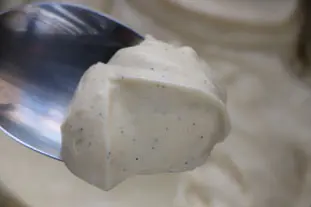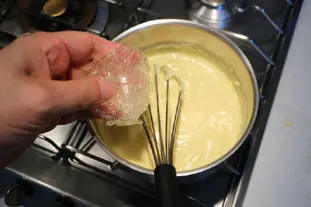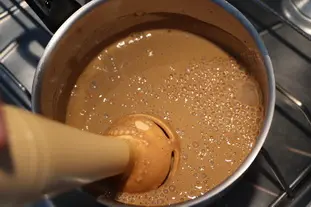The gelling agent in a cream

If you start making a Bavarian cream for example, or any other that contains a gelling agent such as gelatin or agar-agar, you will sooner or later be confronted with the problem: How to properly incorporate this gelling agent into my cream? (and we will focus on gelatin)
14 K 4.9/5 (19 reviews)
Keywords for this post:Gelling agentIncorporationDispersionCreamGelatinBlenderLast modified on: June 18th 2022
The gelling agent in a cream
"Well" means regularly, evenly, so that the consistency of the cream is well homogeneous, and it is not so easy as that.
Well it is often the case in fact, we heat a first mixture for a cooking (like custard) and then we incorporate the gelatin, but it is necessary to remember it anyway.
Then it's a question of structure, the gelatin is in a different form from your cream, which is rather liquid.
The gelatin is either sheets (of 2 gr) or powder, and incorporating it into the structure of your future cream involves some precautions.
If you use powdered gelatin, it's easier: you pour the powder directly into your hot cream, whisking at the same time to disperse immediately.
In practice, you may have some concerns about the homogeneity of your cream, with some areas a little more set than others, especially if your cream was a little low in temperature (< 50°C).
Not only will you disperse the gelatin perfectly, but you will also smooth your cream, which will be even smoother once it has cooled.
This dispersal of gelatin, and of gelifiers in general, in a mixer is a common practice among professional pastry chefs.
Don't hesitate to use this professional trick to obtain very nice and creamy creams at home.
To sum up: To properly incorporate a gelling agent into a cream, you must make it "hot cream" and then disperse it with a mixer for a homogeneous result.
What is the problem?
First of all, it's a question of temperature: gelatin is soluble at 37°C, so it is imperative that your cream is above that temperature, otherwise it will not dissolve.Well it is often the case in fact, we heat a first mixture for a cooking (like custard) and then we incorporate the gelatin, but it is necessary to remember it anyway.
Then it's a question of structure, the gelatin is in a different form from your cream, which is rather liquid.
The gelatin is either sheets (of 2 gr) or powder, and incorporating it into the structure of your future cream involves some precautions.
Sheets and powder
If you use gelatin sheets, you will first have to soften them for 5 minutes in a bowl of cold water, then wring them out (squeeze them in your hand over the sink), pour them into your hot cream and immediately mix them well, we say "disperse", with a whisk for example or with a maryse.
If you use powdered gelatin, it's easier: you pour the powder directly into your hot cream, whisking at the same time to disperse immediately.
Is this enough?
In theory yes, if you did it quickly and well, no problem for your cream.In practice, you may have some concerns about the homogeneity of your cream, with some areas a little more set than others, especially if your cream was a little low in temperature (< 50°C).
Is there a way to ensure a perfect dispersion?
Yes, just give your cream a quick blast with a mixer (less than 10 seconds) once the gelatin is incorporated.Not only will you disperse the gelatin perfectly, but you will also smooth your cream, which will be even smoother once it has cooled.

This dispersal of gelatin, and of gelifiers in general, in a mixer is a common practice among professional pastry chefs.
Don't hesitate to use this professional trick to obtain very nice and creamy creams at home.
To sum up: To properly incorporate a gelling agent into a cream, you must make it "hot cream" and then disperse it with a mixer for a homogeneous result.
Lasts posts
Butter vs. grease
We often read in a recipe where a pastry is put into a mould that, just before pouring, the mould should be buttered or greased. But what's the difference between these 2 terms?December 1st 20258105
Getting out of the fridge early
Very often when you're cooking, you need to take food or preparations out of the fridge, to use them in the recipe in progress. There's nothing tricky about this: you just take them out of the fridge and use them, usually immediately, in the recipe. But is this really a good method?November 24th 20251,0175
Who's making the croissants?
When you look at a bakery from the outside, you naturally think that in the bakery, the bakers make the bread, and in the laboratory, the pastry chefs make the cakes. It's very often like that, with each of these professions having quite different ways of working, but sometimes there's also one...November 23th 2025916
Oven height
When we put a dish or cake in the oven, we naturally tend to put it on the middle shelf, and that's what we usually do. But in some cases, this position and height can be a little tricky, so let's find out why.October 8th 20252,5485
The importance of sieving
In recipes that use a fine powder (flour, powdered sugar, etc.), you'll often see the advice to sift before using it. To sift is to pass the powder in question through a sieve (a very fine strainer) before incorporating it into your recipe. It's often advice, but is it really useful?September 3rd 20257,4093
Other pages you may also like
The bitterness of endives
As I write these lines, we are entering the endive season, and if you like it, it's time to enjoy it, if possible with your local producers. Endive is good, but the reproach that is often made of it, and children in particular, is: "It's bitter! And it is (somewhat) true of course, endives...February 9th 201914 K4.9
Tranché, dissociated, failed, in short... missed!
When preparing a sauce or a cream, there's always a (small) risk that the creamy preparation you're working on will suddenly separate into two parts of different textures: a liquid part, for example, and a more or less solid part, or even become lumpy. It's terribly frustrating, but we'll see...June 19th 202313 K5
Half milk, half cream
In a multitude of recipes, savoury or sweet, milk is used as the main ingredient, or at least as the main liquid ingredient. Milk is used instead of water, for example, because milk contains a proportion of fat, which adds roundness and softness to the recipe. This mellowness is very pleasant on...February 27th 20249,4325
The right size of zucchini
When you buy zucchini at the market, you're often offered a wide variety of sizes, from very small to very large. But which ones to choose? Here are a few tips.September 9th 20249,8955
The beautiful story of the croissants
As you may have already noticed, cooking, baking and pastry-making are full of stories or legends, usually very romantic, about this or that product or recipe. This is often the case for named recipes, for example tarte tatin, peach melba, paris-brest and many others, but it also applies to very...October 10th 201819 K5
Post a comment or question
Follow this page (as 2 people already do)
If you are interested in this page, you can "follow" it, by entering your email address here. You will then receive a notification immediately each time the page is modified or a new comment is added. Please note that you will need to confirm this following.
Note: We'll never share your e-mail address with anyone else.
Alternatively: you can subscribe to the mailing list of cooling-ez.com , you will receive a e-mail for each new recipe published on the site.









